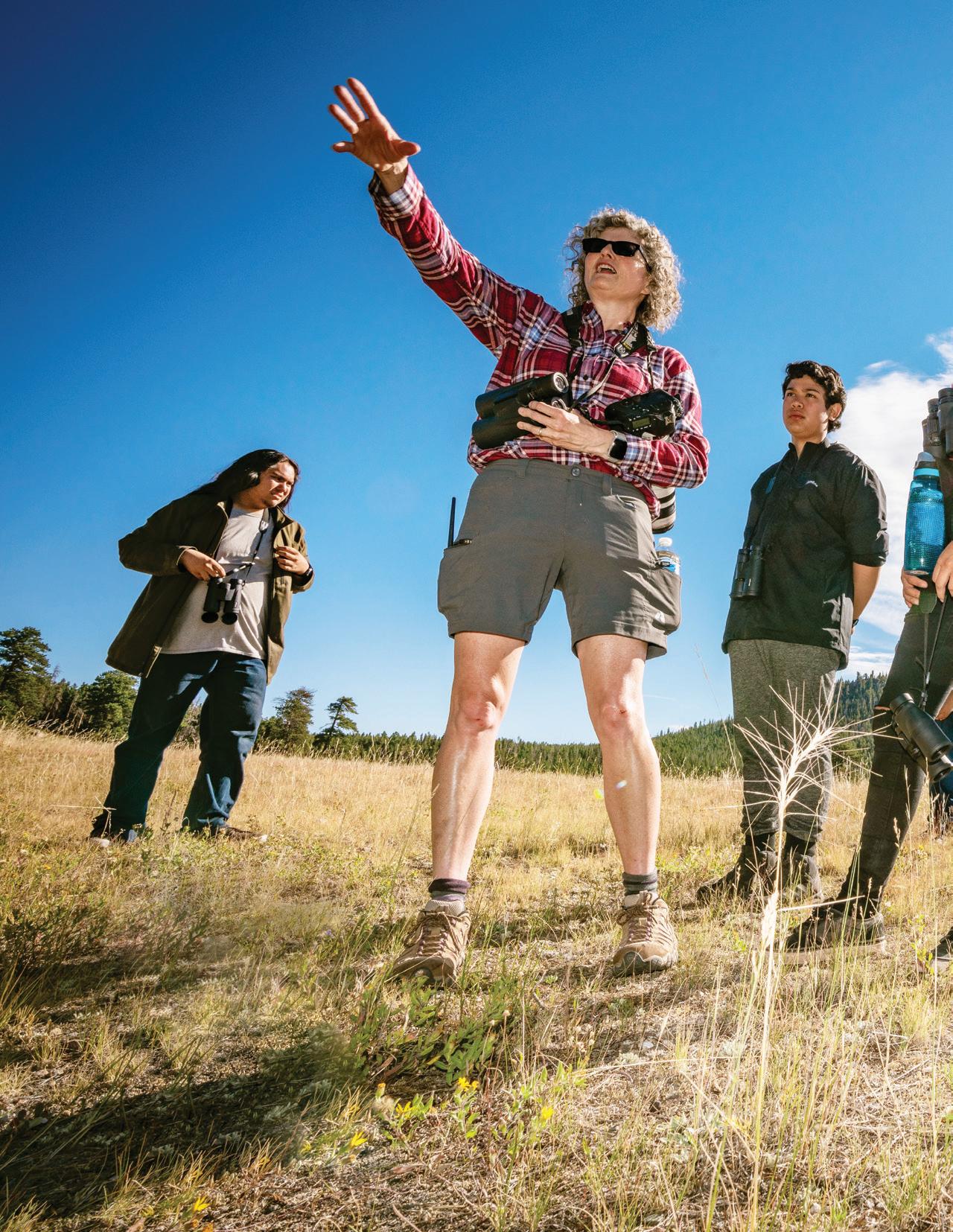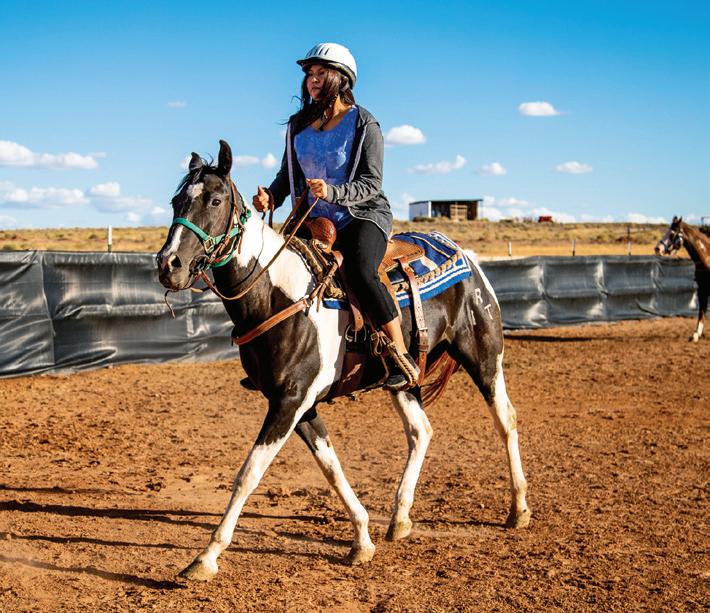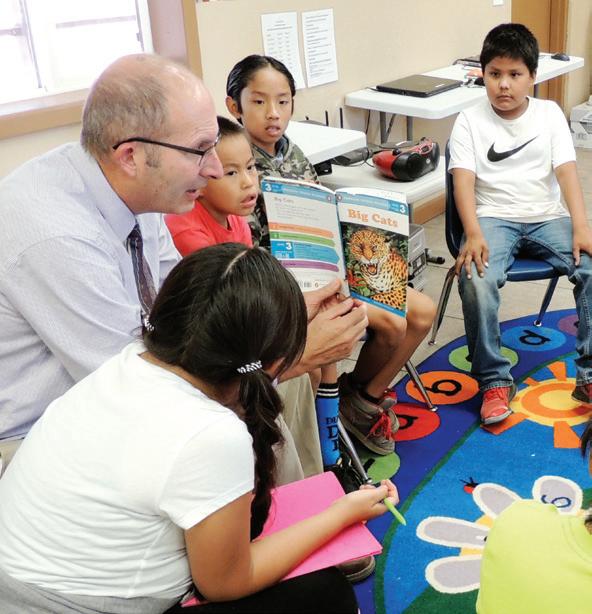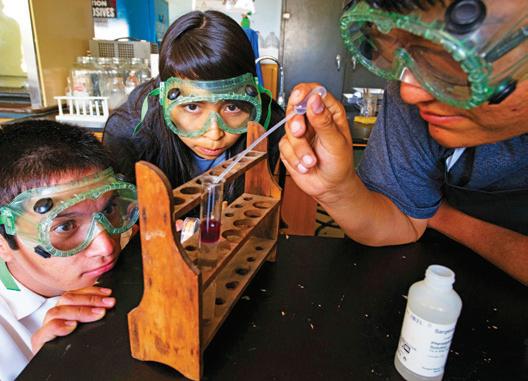
8 minute read
HIS Kids
When they were students together at WWU Pedro and Anita Ojeda never would have guessed they were being prepared for dream jobs they didn't even know they wanted.
By Emily Huso ’17
Looking back at the past 30 years, Pedro ’88 and Anita (Strawn) Ojeda ’87 can see how, through a variety of twists and turns, joys and adversities, God prepared them for their current work supporting Native American youth as educators at Holbrook Indian School (HIS).
HIS is a first- through 12th-grade boarding school just south of the Navajo Nation in Arizona that serves the local Native American community. HIS students represent as many as nine different tribes. Operated by the Pacific Union Conference of Seventh-day Adventists, the school aims to improve every dimension of student wellness, including mental, academic, physical, and spiritual. “Our goal is to help kids find wholeness in the different areas of their lives,” says Anita, who teaches English and history at the school.

Outdoor School at HIS is an effective teaching tool for Anita Ojeda’s English and history classes.
As Pedro, the school’s principal, puts it, the mission of HIS is to combat the effects of abuse, poverty, and generational trauma in the community by “providing a safe haven for Native American students while introducing them to their creator and best friend, Jesus.”
TWISTS AND TURNS
Pedro’s and Anita’s experiences at WWU helped lay the foundation for the important work they do at HIS. Pedro studied business administration and developed a strong work ethic in his job on the college farm. While Anita—who majored in history and Spanish— didn’t decide to be a teacher until her senior year, she developed research skills and an interest in culture that she would later use in her work in education. When they got married in 1988 it was the beginning of a 30-year partnership that both consider instrumental to their growth as educational leaders.
By the time Pedro graduated, Anita had finished her undergraduate degree and was enrolled at Washington State University on a scholarship to study bilingual, bicultural education. When she received a call to teach at Calexico Mission School (CMS) they packed up their few belongings and moved to Calexico, California, not far from the Mexico border.

One HIS student described working with horses in the Horsemanship Program as “peaceful, silent, and safe.”
During their six years at CMS, Pedro discovered an unexpected passion for education when he began serving as a substitute teacher at CMS. Less than a year later, when a position as business manager and vice principal opened at the school, Pedro was selected for the job. “I absolutely loved it,” he says. That experience was the inspiration for his dream to one day be a principal. With a newfound sense of direction, the Ojedas moved so that Pedro could pursue a degree in education at the University of Nevada, Reno. As he completed his student teaching, Anita picked up a master’s degree in English and began teaching English as a Second Language in the public-school system. By then, the Ojeda family had expanded to include two young daughters. Not long after, they answered a call to return to the Pacific Northwest where Anita taught at Mt. Ellis Academy and Pedro at Mt. Ellis Elementary in Montana. Less than a year after their move Pedro was diagnosed with non-Hodgkin lymphoma. In June 2002 the cancer went into remission, only to be followed by a relapse. The cancer had spread to his brain.
“That was the worst year of my life, to date,” Pedro says. During those dark months the Ojedas leaned heavily on their faith and on each other. While Pedro focused on resting and healing, Anita devoted her energies to caretaking. The whole family prayed for a miracle.
After a year of treatment and a stem cell transplant in January 2003, Pedro made a miraculous recovery. With a new lease on life and eager to return to the classroom, he applied for new teaching positions in the area. Despite his strong reputation in the community, no doors opened for him to teach again. He gave up on education and decided to work in construction, little knowing how valuable this twist would be for his future.
During this time, Pedro developed trade skills and gained firsthand experience with life lessons, such as the patience it takes to work with different kinds of people and the perseverance needed to do manual labor in harsh conditions. After several years in the construction industry, however, a number of setbacks redirected him back to his calling in education.
In 2008, the housing market crashed, and one by one Pedro’s job opportunities disappeared. “God just kept shutting doors,” he says. It became clear to him that he needed to heed God’s voice. “That day, I said, ‘God, I’ve given up on education, but today I’m recommitting.”
Pedro finished his requirements for an Adventist administrator credential and began applying for principal positions. He interviewed for the position at Holbrook Indian School and was offered the job. Once more, the Ojedas found themselves preparing for a big move, this time from Montana to Arizona.
THE DREAM JOB
In their first year at Holbrook, Pedro and Anita found that many of the school structures were in desperate need of renovation. “The buildings were put together with band-aids and matchsticks,” Pedro recalls. More importantly, the Ojedas learned that Holbrook kids were not succeeding academically. The students were testing three to nine grade levels below the national average in math and reading. To Pedro, these academic struggles pointed to a greater underlying need: the need for psychological counseling.
“About 98% of our students have experienced trauma or suffer from the effects of generational trauma,” Anita says. Indeed, the statistics within the Native American population paint a grim picture. Studies show that one in three Native women are raped or suffer sexual abuse. Of those who die by suicide, 40% are between the ages of 15 and 24. Nearly half the population never graduates from high school, and only eight out of 100 obtain a college degree. More than 50% of the population live at or below the poverty line. To Pedro, it was clear that the students’ mental health needs must be addressed first and foremost.

Principal Pedro Ojeda takes breaks from administrative work to connect with elementary school students.
School administrators started by hiring one counselor; now there are two. “As the students start to heal, it makes it easier for them to learn,” Anita says. “And as academics become easier, they gain more self-confidence because they’re doing better in school and catching up to their non-Native peers.”

Test scores are on the rise at HIS in both math and reading.
One of Anita’s first projects was to help raise the students’ grade levels by implementing Accelerated Reader and Accelerated Math programs. Having used these programs in the past, Anita was confident that this change would help HIS students advance. Her instinct proved correct. Each year since the new systems have been implemented, the students have improved incrementally. “We actually have four kids in calculus for the first time ever at this school,” Anita says. With higher than ever standardized test scores, HIS students are meeting and exceeding graduation requirements for the first time.
To further support well-rounded education, Pedro and Anita have poured their energies into other projects, including a Garden-to-Plate Program, athletic program, and Outdoor School. Pedro’s construction experience from his time in Montana was helpful with an initiative to restart the Garden-to-Plate Program in the school’s five greenhouses. The program allows students to grow much of the produce served in the school cafeteria.
Pedro has also supported the start of an athletic program with a focus on physical fitness and teamwork. Observing how much the kids enjoyed riding the school’s ragtag, run-down bicycles, Pedro appealed for donations for new bicycles. With these donations, he purchased 10 new bikes and began taking students on mountain bike trips in nearby Sedona, Show Low, and Flagstaff. “Our students have never done anything like this until they go with me,” says Pedro. “It teaches them so much character, so much leadership, and so much about themselves.” Meanwhile, Anita organized Outdoor School for the students, taking them on trips to locations including the Grand Canyon, Rocky Mountain National Park, and Kodachrome Basin.
Anita has also started projects such as the Navajo Long Walk and Voices of Native Youth to provide opportunities for students to learn more about Native American history and to help regain their voices. For the Navajo Long Walk, Anita and her class retrace the path the Navajos took on their two-month forced march from Navajo land in Arizona to Fort Sumner in New Mexico. The students research and plan the trip, which gives them the chance to explore history and to ask whose version of events is recorded in history books. “I always ask them, ‘Who’s left out of telling the story? What do we need to discover so that we have a fuller picture?’” Anita says.
In an effort to give her students a platform to express their perspectives on issues that matter to them, Anita started a blog called Voices of Native Youth. As part of their culminating work for history and English classes, the students write and publish essays on the blog about a wide range of topics such as cultural appropriation in Halloween costumes or the difficulties of breaking the cycle of poverty.
With HIS students now meeting graduation requirements, Pedro and Anita’s next priority is to prepare them to take the next step toward higher education. To this end, as part of their senior class trip, the students visit prospective college campuses, including WWU. The visits expose students to life on a college campus and connect them with resources that can help them be successful when they attend. Anita believes that at WWU her students will find the welcoming environment that she and Pedro enjoyed when they attended. “Walla Walla is kind of like family,” Anita says, recalling all the people at WWU who went out of their way to help her and Pedro succeed years ago. The caring family environment they enjoyed at WWU is one that both she and Pedro are committed to creating for the students at HIS.
“We have kids around Friday nights for cookies, we hang out with them, we try to do life with them,” Anita says. The Ojedas believe HIS students are as capable as any other students in the world, and they are dedicated to supporting the success of HIS kids. “I haven’t looked at one principal position post since I’ve been here,” Pedro says. “I am here until God makes it clear to me that He wants me to move on. These kids are worth it.”
Learn more about the work at HIS at holbrookindianschool.org.

